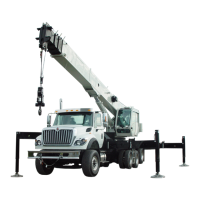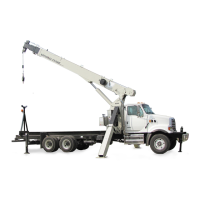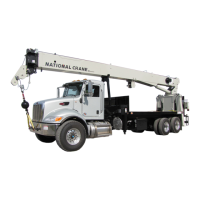National Crane 3-29-2018 Control # 610-00 3-13
NBT40-1 SERIES OPERATOR MANUAL SAFETY INFORMATION
WORK PRACTICES
Personnel Considerations
Do not wear loose clothing or jewelry that can get caught on
controls or moving parts. Wear the protective clothing and
personal safety gear issued or called for by the job
conditions. A full-body harness with an appropriate lanyard,
hard hat, safety shoes, ear protectors, reflective clothing,
safety goggles, and heavy gloves may be required.
Aerial Lift Access
You must take every precaution to ensure you do not slip
and/or fall off the aerial lift. Falling from any elevation could
result in serious injury or death.
Never exit or enter the aerial lift cab or deck by any other
means than the access system(s) provided (i.e., steps and
grab handles). Use the recommended hand-holds and steps
to maintain a three-point contact when getting on or off the
aerial lift.
If necessary, use a ladder or aerial lift to access the boom
nose.
Do not make modifications or additions to the aerial lift’s
access system that have not been evaluated and approved
by Manitowoc Crane Care.
Do not step on surfaces on the aerial lift that are not
approved or suitable for walking and working. All walking and
working surfaces on the aerial lift should be clean, dry, slip-
resistant, and have adequate supporting capacity. Do not
walk on a surface if slip-resistant material is missing or
excessively worn.
Do not use the top of the boom as a walkway.
Do not step on the outrigger beams or outrigger pads (floats)
to enter or exit the aerial lift.
Use the hoist access platform (if equipped) when working in
the hoist area.
Wear shoes with a highly slip-resistant sole material. Clean
any mud or debris from shoes before entering the aerial lift
cab/operator’s station or climbing onto the aerial lift
superstructure. Excessive dirt and debris on the hand-holds,
access steps, or walking/working surfaces could cause a
slipping accident. A shoe that is not clean might slip off a
control pedal during operation.
Job Preparation
Before aerial lift use:
• Barricade the entire area where the aerial lift is working
and keep all unnecessary personnel out of the work
area.
• Ensure that the aerial lift is properly equipped including
access steps, covers, doors, guards, and controls.
• Conduct a visual inspection for cracked welds, damaged
components, loose pins/bolts, and wire connections.
Any item or component that is found to be loose or
damaged (broken, chipped, cracked, worn-through, etc.)
must be repaired or replaced. Inspect for evidence of
improper maintenance (consult your Service Manual).
• Check for proper functioning of all controls and operator
aids (e.g. RCL).
• Check all braking (e.g. wheel, hoist, and swing brakes)
and holding devices before operation.
You must ensure that the outriggers and stabilizers are
properly extended and set before performing any
operations.
Clear all personnel from the outrigger area before extending
or retracting the outriggers. Carefully follow the procedures
in this Operator Manual when extending or retracting the
outriggers. Death or serious injury could result from improper
aerial lift set up on outriggers.
Be familiar with surface conditions and the presence of
overhead obstructions and power lines.
Working
Operator shall be responsible for all operations under his/her
direct control. When safety of an operation is in doubt,
operator shall stop the aerial lift’s functions in a controlled
manner. Aerial lift operations shall resume only after safety
concerns have been addressed.Know the location and
function of all aerial lift controls.
Make sure all persons are away from the aerial lift and the
Travel Select Lever is in the “N” (Neutral) position with the
parking brake engaged before starting the engine.
WARNING
FALL HAZARD!
Working at elevated heights without using proper fall
protection can result in severe injury or death.
Always use proper fall protection as required by local,
state or federal regulations.
WARNING
Fall Hazard!
Working at elevated heights without using proper fall
protection can result in severe injury or death.
Always use proper fall protection as required by local,
state or federal regulations.

